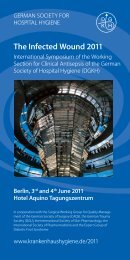Anforderungen an die Hygiene bei der Auf - Deutsche Gesellschaft ...
Anforderungen an die Hygiene bei der Auf - Deutsche Gesellschaft ...
Anforderungen an die Hygiene bei der Auf - Deutsche Gesellschaft ...
Erfolgreiche ePaper selbst erstellen
Machen Sie aus Ihren PDF Publikationen ein blätterbares Flipbook mit unserer einzigartigen Google optimierten e-Paper Software.
29<br />
Empfehlung <strong>der</strong> Kommission für Kr<strong>an</strong>kenhaushygiene und Infektionsprävention <strong>bei</strong>m Robert Koch-Institut (RKI)<br />
Recommendation of the Commission for Hospital <strong>Hygiene</strong> <strong>an</strong>d Infection Prevention at the Robert Koch Institute (RKI)<br />
• Direkter Haut- o<strong>der</strong> Schleimhautkontakt mit Blut<br />
o<strong>der</strong> <strong>an</strong><strong>der</strong>en Körperflüssigkeiten ist zu vermeiden.<br />
Zum Schutz vor Verletzungen müssen geeignete<br />
Maßnahmen getroffen werden (Unfallverhütungsvorschrift<br />
[117]) (Kategorie IV).<br />
2 Schutz vor Kontamination<br />
• Zum Schutz vor Kontamination tragen endoskopierende<br />
Ärzte und assistierendes Endoskopiepersonal<br />
<strong>bei</strong> <strong>der</strong> Endoskopie Bereichskleidung, Einmalh<strong>an</strong>dschuhe,<br />
ggf. Mund-Nasen-Schutz und Schutzkittel<br />
[73, 74, 128] (Kategorie IB).<br />
• Bei Patienten, <strong>bei</strong> denen ein Verspritzen von Blut<br />
o<strong>der</strong> Körpersekreten wahrscheinlich ist (z. B. <strong>bei</strong><br />
Notfallendoskopie <strong>bei</strong> oberer GI-Blutung) und <strong>bei</strong><br />
Patienten mit übertragbaren Erkr<strong>an</strong>kungen (Tuberkulose,<br />
Hepatitis B, C, HIV) werden zusätzlich<br />
Mund-Nasen-Schutz und Schutzbrille getragen.<br />
Bei Bronchoskopie von Patienten mit offener Tuberkulose<br />
<strong>der</strong> Atemwege sind vom Personal generell<br />
Feinstaubmasken (FFP-2Masken) zu tragen. Chirurgische<br />
Masken schützen nicht vor <strong>der</strong> Inhalation<br />
von mikroorg<strong>an</strong>ismenhaltigem Aerosol (Kategorie<br />
IB).<br />
• Während <strong>der</strong> <strong>Auf</strong>bereitung des Endoskopes werden<br />
schnittfeste H<strong>an</strong>dschuhe und flüssigkeitsdichter<br />
l<strong>an</strong>gärmliger Schutzkittel/Bereichskleidung und<br />
Plastikschürze, Mund-Nasen-Schutz und Schutzbrille<br />
getragen, um mögliche Kontakte <strong>der</strong> Haut und<br />
Schleimhäute mit Erregern nosokomialer Infektionen<br />
zu vermeiden (Kategorie IB).<br />
• Grundsätzlich ist nach jedem Patienten eine sorgfältige<br />
Flächendesinfektion des patientennahen<br />
Bereichs (z. B. Untersuchungsliege) und ggf. eine<br />
Fußbodendesinfektion nach Verunreinigung durchzuführen.<br />
Endoskopische Untersuchungen aerogen<br />
infektiöser Patienten sollen am Ende des Ar<strong>bei</strong>tsprogramms<br />
durchgeführt werden (Kategorie IB).<br />
3 Schutz vor Verletzungen<br />
• Da im medizinischen Ar<strong>bei</strong>tsbereich Nadelstichverletzungen<br />
<strong>die</strong> weitaus häufigste Ursache für eine<br />
Exposition mit Hepatitisviren o<strong>der</strong> HIV darstellen,<br />
sind Maßnahmen zum Schutz vor Verletzungen<br />
beson<strong>der</strong>s wichtig (Unfallverhütungsvorschrift [117]/<br />
Kategorie IV).<br />
• Zur sicheren Entsorgung von spitzen o<strong>der</strong> scharfen,<br />
potenziell kontaminierten Gegenständen wie K<strong>an</strong>ülen<br />
sind bruch- und durchstichsichere Behälter zu<br />
verwenden (Kategorie IB).<br />
• Gebrauchte K<strong>an</strong>ülen sind nicht in <strong>die</strong> Plastikschutzhülle<br />
zurückzustecken, zu verbiegen und<br />
abzuknicken [116], son<strong>der</strong>n direkt, d. h. ohne Weiterreichung<br />
<strong>an</strong> das Endoskopiepersonal, in einem<br />
am Gebrauchsort vorh<strong>an</strong>denen bruch- und durchstichsicheren<br />
Behälter zu entsorgen (Kategorie IB).<br />
• Beim Umg<strong>an</strong>g mit Biopsiez<strong>an</strong>gen müssen Verletzungen<br />
vermieden werden. Die m<strong>an</strong>uelle Reinigung<br />
von Biopsiez<strong>an</strong>gen, vor allem solchen mit Dorn, hat<br />
daher sehr sorgfältig und umsichtig zu erfolgen –<br />
with blood or other body fluids must be avoided.<br />
Adequate measures must be taken as a protection<br />
against injuries (Accident Prevention Regulation<br />
[117]) (Category IV).<br />
2 Protection Against Contamination<br />
• During endoscopy, endoscoping physici<strong>an</strong>s <strong>an</strong>d<br />
assisting endoscope staff wear nursing scrubs,<br />
disposable gloves, where appropriate, masks<br />
covering mouth <strong>an</strong>d nose, <strong>an</strong>d protective gowns<br />
to safeguard against contaminations [73, 74, 128]<br />
(Category IB).<br />
• In addition, masks covering mouth <strong>an</strong>d nose <strong>an</strong>d<br />
goggles are worn in case of patients where splashing<br />
of blood or body secretions is likely (e.g. emergency<br />
endoscopy in the event of upper GI bleeding)<br />
<strong>an</strong>d in case of patients with contagious diseases<br />
(tuberculosis, hepatitis B, C, HIV). Staff must always<br />
wear fine-dust masks (FFP-2 masks) in case of<br />
bronchoscopy of patients with open tuberculosis of<br />
the respiratory tract. Surgical masks do not protect<br />
against inhaling microorg<strong>an</strong>ism-containing aerosols<br />
(Category IB).<br />
• Cut-resist<strong>an</strong>t gloves <strong>an</strong>d liquid-proof, long-sleeved<br />
protective gowns/nursing scrubs <strong>an</strong>d plastic aprons,<br />
masks covering mouth <strong>an</strong>d nose <strong>an</strong>d goggles are to<br />
be worn during endoscope reprocessing to avoid<br />
possible contacts of the skin <strong>an</strong>d mucous membr<strong>an</strong>e<br />
with pathogens of nosocomial infections (Category<br />
IB).<br />
• After each patient, diligent surface disinfection of the<br />
near-patient area (e.g. examination couch) must be<br />
performed at all costs <strong>an</strong>d, where appropriate, floor<br />
disinfection after contamination. Endoscopic examinations<br />
of aerogenic infectious patients should be<br />
conducted at the end of the working schedule (Category<br />
IB).<br />
3 Protection Against Injuries<br />
• Measures for protecting against injuries are particularly<br />
import<strong>an</strong>t (Accident Prevention Regulation<br />
[117]/Category IV), because needle stick injuries<br />
are by far the most frequent cause for exposure<br />
to hepatitis viruses or HIV in the medical working<br />
field.<br />
• Breakproof <strong>an</strong>d puncture-proof receptacles must<br />
be used for safely disposing of sharp, potentially<br />
contaminated objects, such as hypo<strong>der</strong>mic needles<br />
(Category IB).<br />
• Used needles must not be replaced in their protective<br />
plastic covering <strong>an</strong>d must not be bent or<br />
snapped off [116] but must be disposed of promptly,<br />
i.e. without passing them on to the endoscopy staff,<br />
in a break-proof <strong>an</strong>d puncture-proof receptacle that<br />
is available at the place of use (Category IB).<br />
• Injuries must be avoided when dealing with biopsy<br />
forceps. M<strong>an</strong>ual cle<strong>an</strong>ing of biopsy forceps, especially<br />
those with spikes, must thus be performed<br />
thoroughly <strong>an</strong>d with the utmost care – a hepatitis<br />
Erstmalig veröffentlicht in Bundesgesundheitsbl Gesundheitsforsch – Gesundheitsschutz | first published in Fe<strong>der</strong>al Health Gazette Health Research – Health Protection<br />
2002 • 45:395–411 © Springer-Verlag 2002



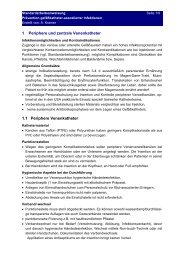
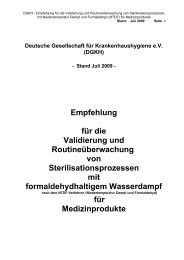


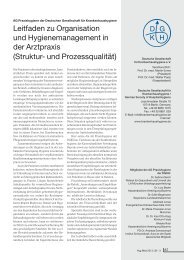

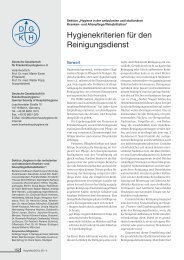


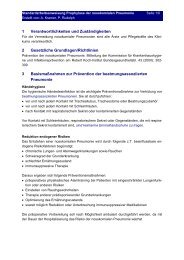

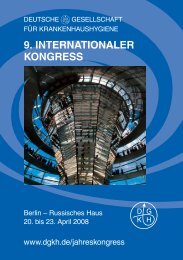
![Hauptprogramm [A4-Quer] - Deutsche Gesellschaft für ...](https://img.yumpu.com/6449478/1/184x260/hauptprogramm-a4-quer-deutsche-gesellschaft-fur-.jpg?quality=85)
